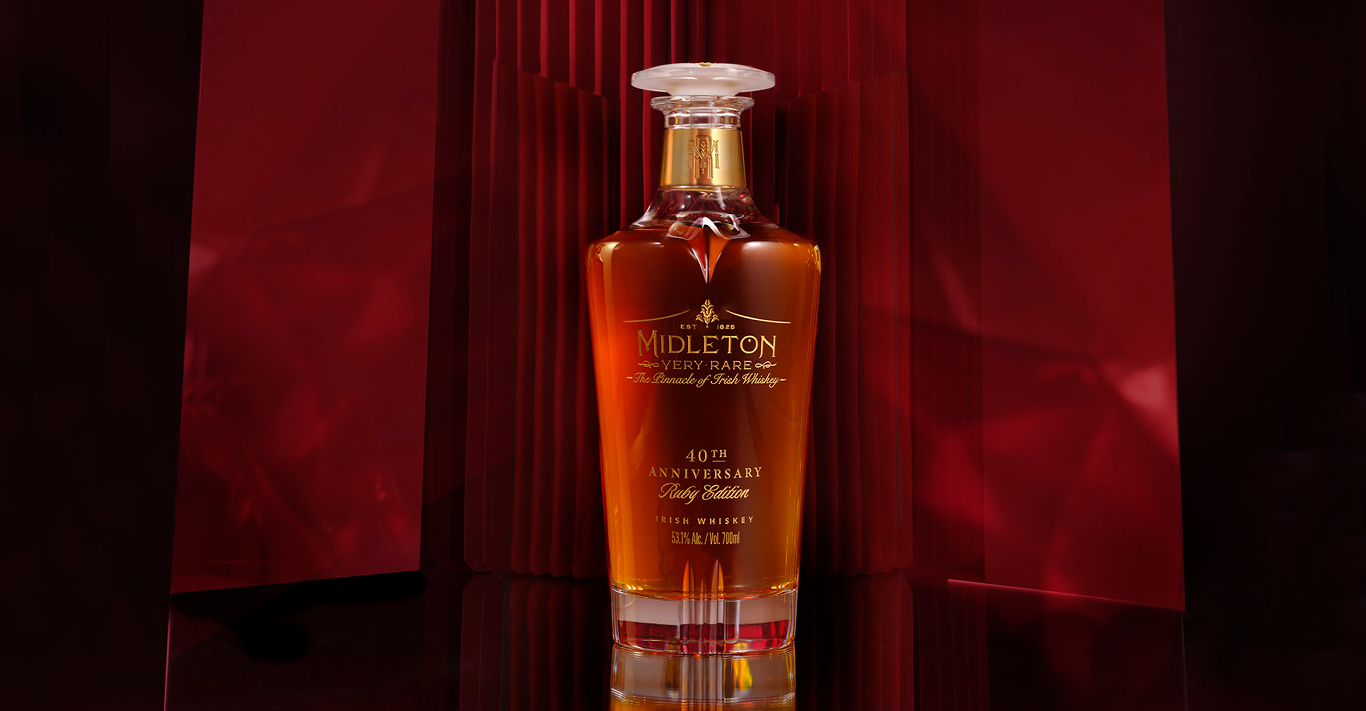WORDS
Chris Madigan
Since 1984, at around this time each year, Irish Distillers releases its annual prestige whiskey, Midleton Very Rare. Most years, there are fewer than 10,000 bottles available globally (this year, fewer than 8,500). But this year, there’s an even rarer version of the whiskey to celebrate the brand’s 40th anniversary – the Ruby Edition.
First, the regular release, because it helps explain how this whiskey is made. Master distiller Kevin O’Gorman says, ‘At the Midleton Distillery, we can produce pot still whiskey and grain whiskey. Midleton Very Rare is a blend of both. Grain is produced from a mash bill of maize and malted barley, distilled in vertical column stills. You get a distillate at about 94 per cent, that is elegant, floral and herbal. Pot still whiskey is produced from a mash bill of barley and malted barley, distilled in copper pot stills. That comes off the still at 84 per cent. And it’s more robust, with dark fruits and spice. For Middleton Rare, we bring the two styles together in a blend.’

It is the same process as for Jameson whiskey, also produced there – albeit in far higher volumes. There isn’t a set ratio for the blend – it’s the choice of the master distiller each year. And they have other variables they can play with, including setting the pot stills to produce a light, medium or heavy spirit. Those spirits, and the grain spirit too, can be aged in different casks to create even more variety, although the differences are subtle. O’Gorman continues, ‘It’s always matured in what we call ex-American whiskey barrels. So, we don’t age in sherry, port or wine casks – only ex-bourbon or other American whiskeys. We use first fills, which we call B1, where you pick up a lot of vanilla, toffee, honey. But we can also reuse it as a B2, where the influence is more subtle, or a third time, as a B3. So, I can play tunes with those different styles, so each year has a different character.’
The final variable O’Gorman has to play with is time itself. Midleton Very Rare is a non-age-statement whiskey, although it’s generally acknowledged to be blended from elements at least 12 years old, including splashes of much, much older liquids. O’Gorman is the third master distiller of Midleton Very Rare, taking over in 2020 from Brian Nation, whose seven years in the job followed the rather longer tenure of Barry Crockett. The man who created MVR in 1984, three years after he took over from his father in the role, was literally born to the job – in the Distiller’s Cottage on the grounds of the Old Midleton Distillery, now part of the Jameson Experience.
It was Crockett – who still occasionally pops in like an Alex Ferguson figure (‘no pressure,’ laughs O’Gorman) – who set the parameters for MVR ‘precisely blending very singular elements’. In his vintages so far, including the 2024, O’Gorman is not working with liquids he oversaw the distillation of – he’s blending from what his two predecessors laid down for him, while creating the range of ingredients for a future chef.

The exception is the one-off 40th Anniversary Ruby Edition. He selected the casks, each filled under his, Nation’s and Crockett’s purview. They were already blends – he then vatted them in a single ruby port pipe to finish the whiskey in an appropriate vessel. Crockett’s 2005 whiskey gives the blend a leathery nuttiness, with just-prepared crème brûlée on the nose, fruit and nut chocolate and a touch of spice, meanwhile Nation’s 2014 liquid is citrus and flower-bed aromas, with pepper and salted caramel, and then O’Gorman’s 2021 element is a child prodigy at three years old – fresh-cut grass on the nose, poached pears in the mouth. The port finish adds tannins to create structure around which these different flavours whirl, with red fruit added to the mix.
There are 550 bottles (£17,558) available worldwide. Or rather 549 – bottle number one, a one-off with a 22-carat gold collar embedded with rubies – was auctioned for $120,000. However, that can still be acquired by making an offer for the asset-backed NFT (essentially a certificate of ownership of the physical bottle, which is in Singapore avoiding custom duties while it changes hands).
It all makes the Midleton Very Rare 2024 (£180) seem a snip. Which, given the amount of work that goes into selecting and blending, it arguably is. O’Gorman lets us into his creative process: ‘I brought the grain component up slightly from last year. So, the floral, rosewater, cut-grass notes are on the higher side. But I also brought up the B1 cask element so, on the nose, as it rolls on, you get vanilla, toffee or butterscotch notes. In terms of the pot still style, I used mainly medium pot still. It’s luscious and fruity – ripe apple, pears coming through and a touch of citrus as well. And then you have the vanilla and fudge through to a long finish.’
Brummell’s own tasting notes pick up hay, peach skin and raspberry on the nose; honey and candied orange peel on the palate; and barley sugars to finish.
To enquire about one of the 549 bottles of Midleton Very Rare 40th Anniversary Ruby Edition (£17,558), go to midletondistillerycollection.com




